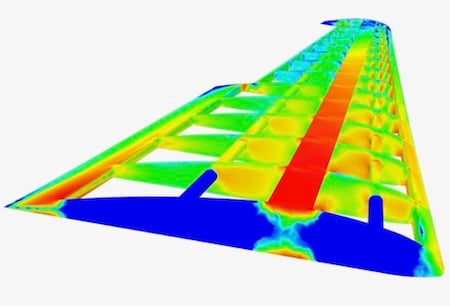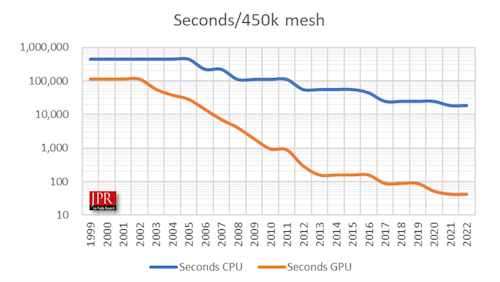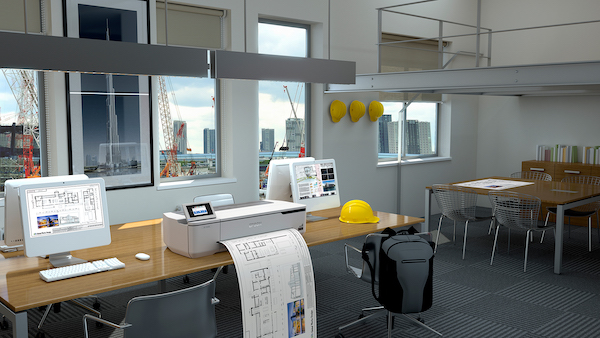
When most people think of CAE simulation programs they think of FEA or CFD because they are the most commonly used applications.
FEA and CFD programs have been around since the 1950s, initially running on big (at the time) mainframes, then time-share systems, then mini-computers, and finally on x86-based workstations. The basic
F = kδ Rayleigh-Ritz method formulas haven’t changed, but the resolution of measurement has decreased immensely by orders of magnitude and improved accuracy and reliability. As more performance, measured in millions of operations per second (MIPS), became available, the resolution of the models increased and then rendering time, much like it is in computer graphics, stayed rather constant. Adding MIPS however, allowed for a quick, low-resolution look to get a feel for what was going on before running a full solver operation.
Once the domain of specialists with high-powered computers, CAE is becoming a workstation application for designers. Earlier this year, Jon Peddie Research conducted a series of interviews with leading CAE software vendors such as Altair, Ansys, Dassault Systèmes, Hexagon, and Siemens Digital Industries Software. JPR also worked with Nvidia to understand how the industry is changing in response to GPU acceleration now available in many CAE applications and workflows. The results of those interviews are available in a free eBook titled Accelerating and Advancing CAE.
The transition has not been a quick one. GPUs were introduced at the end of 1999 in response to high demand from enthusiastic gamers who were fervently embracing 3D gaming. The first GPUs were expressly designed for games and game developers could simply write to the GPU’s built-in functions. As application programming interfaces (APIs) evolved, those functions multiplied exponentially. The effect was immediate; the number of games written for GPUs increased rapidly, games ran faster, and they became more beautiful. You can find out more about this in “The History of Visual Magic in Computers: How Beautiful Images are Made in CAD, 3D, VR and AR.”
With the benefit of hindsight, we now know the same transformation was on the way for engineering and scientific calculations — but a lot had to happen before the design industry was ready. All the software had been built for CPUs and customers were used to depending on the power of their systems’ CPUs to run complex, resource heavy simulation and analysis software. They were also used to analysis software being complex and taking a very long time to run.
Everything Goes Faster
As the pace of innovation accelerates, each successive generation of GPU gets new features that are useful for CAE, including hardware-accelerated matrix math and AI, faster memory, and higher bandwidths. Also, software tools for programming GPUs continue to proliferate. Introduced in 2007, Nvidia’s CUDA enabled the development of specialized libraries for uses across the computing universe. AMD has been working on open software approaches, and so has Intel which is introducing new high-powered GPUs to complement its CPUs.
In our interviews with the CAE companies, we were told that GPUs are outperforming CPUs by many multiples depending on the specific tasks, but in spite of this obvious advantage, we were also told that some engineers worry that GPU-accelerated applications might have to pay for the speed boost with accuracy. That has not proved to be the case. Instead, developers and their customers are finding the results from GPU-accelerated calculations to be as accurate as those performed on CPU-based solvers.
GPU acceleration is enabling workstations to do the jobs that were previously performed by high-performance computing (HPC) machines. As a result, performing those jobs can be less expensive in terms of energy use and financial costs. The ability to perform more iterations, less expensively and more sustainably is enabling more designers to take advantage of simulation earlier in the design process and to have confidence in the results.
Industries do not transition overnight, and the CAE industry is a particularly good example. Some of the products are based on very old code originally written for CPUs in the 1960s and 1970s. How these companies take advantage of GPUs may vary. The companies we interviewed told us that they’re in the early stages of working with GPUs for CAE. They’ve been aware of the benefits of GPUs for a long time, but they’re even more aware of the pitfalls of moving too fast. Developers have to consider the installed hardware base at their customer sites and what kind of problems they are trying to solve.
Since their introduction, GPUs have been evolving to support all digital industries. They have gotten more transistors, larger memory, and faster bandwidths. New types of accelerator cores such as Nvidia's CUDA Cores and AMD’s Stream Processors have been developed, and Tensor cores have been added to accelerate AI/ML applications. Real time ray tracing cores have been introduced and a plethora of developer software tools and libraries have been developed. The net result is the GPU has leapt ahead of the CPU in reducing the time needed to process simulation meshes as characterized in the graph below.
As the core count increases, the time to compute decreases and when properly employed, the GPU provides astonishing acceleration. Click image to enlarge
Some of the ISVs are sticking with CPUs, some of the newer companies and new programs are moving to the GPU. The most sensible approach in our opinion is a hybrid approach that lets the user employ whatever GPU capabilities they have.
There are several clear takeaways from this project, the use of GPU acceleration in established CAE products is increasing. And we’re also seeing the development of new products written from the ground up to take advantage of GPUs. Sustainability has become an important consideration for developers and customers. And, finally, CAE has the potential to become a more integrated part of the design process which leads to better designs and more sustainable products.
In a few years, this discussion will an amusing historical footnote. Engineers, mathematicians, and scientist will smirk over a drink and say, “Do you remember back in the day when we ran sim on a single processor — boy those were the bad old days.”
Jon Peddie
Jon Peddie is president of Jon Peddie Research, a consulting and market forecasting service. A pioneer of the graphics industry, he is an advisor, lecturer, book author, and frequently quoted technology expert. www.jonpeddie.com.
View All Articles



Share This Post